|
BIRDING TRIP REPORT:
Texas:
Houston, Galveston & Gulf Coast
28 January to
11 February 2017
By Stephen
Burch, England
Introduction
I was last in the USA (and Texas) in November
2007, on the back of a business trip to Houston and had a highly
memorable few days in the
Rio Grande Valley. When a further business opportunity arose
almost ten years later, naturally I was keen to make the most of
it birdwise again! This time I was able to spend some time
during the weekend prior to my work commitment and then just over a
week afterwards.
On the last visit I had decided there was no
time to take in the Whooping Cranes around Rockport, but this
seemed the ideal opportunity to try for them! From some research
beforehand, it seemed that there were also some worthwhile sites
scattered around the Houston area. Galveston looked like a
reasonable base for a few days, especially as my wife decided
she would like to join me for the second week.
Having visited the USA about 6 times over the
last 30+ years, my USA list is now higher than my UK one! Hence
the number of possible lifers for me on this trip was limited,
with Whooping Crane being the main one. I was also keen to find
a large flock of Snow Geese, as the only ones I have seen
in the UK have been odd stragglers often viewed at a great
distance. Finding some smaller Ross' Geese in amongst them was
also a key target. Having missed Red-cockaded Woodpecker
on a visit to Florida several years ago, this one another target
in my sights. Having seen the controversial but splendid
Hooded Merganser at
Radipole
Lake a couple of years ago, finding a definitely
tickable one would be good as well!
General
Flights
I flew BA direct from Heathrow to Houston and
return. The flight takes 9+ hours but didn't seem excessively
long. Both flights departed a little late but arrived on time or
early. On arrival at Houston I had a long and tedious wait to
get through immigration -mainly because I was unluckily assigned
to an extraordinarily slow moving queue. My wife, arriving a
week later, fared better and was out within about 40mins of
touchdown, whereas it had taken me a good one and a half hours!
Car hire
For my car hire, I had a slightly awkward
arrangement in that the first week was a business hire through
Avis, which I immediately followed with a private hire for the
second week, again booked with Avis for convenience, I thought.
When I first collected my car it was clear I needed to return
it, for the booking to be swapped over or changed. Also the car I
had for the first week was fine for me alone, but for the second
week I decided something a little larger would be better to
accommodate all our luggage!
So on the middle Saturday, I had to return to Houston
airport, well before my wife was due to arrive on the later BA
flight, and change the car over. This turned out to be a far from
straightforward process (possibly because of a shortage of cars
caused by the Superbowl that was taking place the following day
in Houston!). Dropping off the old car wasn't an issue, but
getting a suitable new one was...
I first had a considerable wait for a car that was supposed
to be ready in "10 minutes" but never turned up. So they upgraded
me FOC to a splendid, brand new luxury model which seemed great but
as I drove off, the rear view mirror seemed a bit dicey. After
doing a short bit of birding at the W G Jones State Forest (more
of which below), I set out to return back to the airport to
collect the wife, whereupon the rear view mirror promptly fell
off, and was left dangling by two wires! So I had to return this
brand new, luxury (but defective model) to Avis, and had some
further issues over a replacement before eventually they found a
suitable one for me. This left me just enough time to drive to
the short stay car parking for terminal D and grab a bite eat
before my wife appeared! So all was well in the end, but not
something I'd like to repeat in a hurry!
By the way, Terminal D (the main international terminal at
Houston airport) appears notable for its almost complete lack of anywhere
to eat outside security. There was nothing at all in departures
and only a small Costa Coffee or similar downstairs in the pokey
arrivals hall. On our return journey we found that even through
security its facilities were hardly extensive.
Driving in the USA
Compared with England, there are a few things
that are different and useful to know about driving in the USA,
including:
- Drive on the right!
- You can turn right at red lights if there is no traffic
coming
- Beware 4-way junctions where nobody has priority. A kind
of generally polite free for all seems to prevail, with those
arriving first generally given priority.
- Traffic lights are generally on the far side of the
junction and often up in the air
- Speed limits can be almost anything between about 30 and
75 mph, and often change frequently over a short
distance (30, 40, 50, 60 etc).
- Roads are generally wide and quieter than England,
except of course in and around big cities such as Houston.
Maps
As in 2007, maps for Texas were a bit problematic. I had a 1:1,000,000
scales Texas State Map (Mapsco) from my previous trip but that
was too small a scale to be much use. Stanfords didn't appear to
offer any larger scale regional maps, so as with most previous
recent trips, I relied almost entirely on my SatNav - using lat, long (GPS) coordinates I had stored in advance.
In some cases these were supplemented by Google Map printouts of key areas.
In 2007, before the SatNav era, I seem to remember navigation
was a bit more of an issue.
Birding information
Well in advance, I eventually ended up buying 3 site guides,
all fortunately either second hand or at discounted rates.
The first was "Birding Texas" by Wauer and Elwonger. This was
quite a tome, and appeared very dated. I then found there were
two books about the "Great Texas Coastal Birding Trail". The
better of these was "finding birds on the Great Texas Coastal
Birding Trail" by Eubanks et al. but this only covered areas
near to Houston and Galveston and did not extend as far along the
coast as Rockport. A thicker book by Foster called "Birding
Trails Texas Gulf Coast" covered all sites, but was
extraordinarily error strewn. In particular none of its GPS coordinates that I checked were accurate or useful!
Shortly before I departed I found that there is a great
website that covers all the hundreds of sites on
what are now termed the "Great Texas Wildlife Trials" - that
extend all along the full length of the Texas coast and inland
in places. The info on this site seemed better and more up to date than any
of the above books!
However, the huge number of sites described in the above can
be quite confusing as many are probably not particularly notable
and so picking out the ones to target, in winter, in a short
space of time can be difficult.
Weather
The weather
was literally very mixed and highly variable. The first half of
my trip, including the business part, was mostly favoured with
blue skies and warm, sunny conditions (up to mid 20's C). But
immediately I started birding after the business part, the
weather changed and the middle weekend around Houston was dull,
dreary and cool - very much like a typical mild English winter's day
in fact! Thereafter it warmed up and the sun returned for at
least some of the time. The highest temperature was well over
30C - near record highs for the time of year, apparently. On the
coast, early morning fog which only cleared slowly was also a
problem some days, even in these better conditions. By great good
fortune, there was no sign of any fog on our early morning boat
trip from Rockport for the Whooping Cranes - apparently this was the first morning in a few
weeks that it had been clear!
Photos
All the pics shown
below were taken with my DSLR equipment - Canon EOS 7D Mk II
with either a new
EF500mm/f4 II (with a x1.4TC) or a EF100-400f5.6 II.
All pics were taken in RAW format, and I use NeatImage for
noise suppression, with PhotoShop Elements 9.0 for
subsequent processing. For further details see the equipment and image processing pages elsewhere on this website.
Sites in the Houston area
I targeted various sites in the
Houston area immediately after I arrived in Houston (Saturday
late afternoon & Sunday), and again
before collecting my wife from the airport on the middle
Saturday.
W G Jones State Forest
(GPS
30.234773, -95.483877)
According to my
information, this site was a good place to find the localised
Red-cockaded Woodpecker (or RCW). There is a
good map of this site on the
Texas A &
M Forest Website which shows numerous trails.
I visited this site three times
and connected with this desirable woodpecker every time! My
first visit was somewhat speculative and immediately after
arriving in Houston and getting the first of my
hire cars. It was less than half an hour's drive north from the
airport, and the obvious place to start appeared to be the small
car park on the north side of the FM1488 adjacent to the
(closed) Park Headquarters. Arriving around 5pm local time
(around 11 pm UK time!), from the car park I took the path north
and followed signs for the Red-cockaded Woodpecker
trail. This seemed to be aptly named as at the far point of this
little loop, where the path turns north, I heard various bird
calls and quickly saw up to 3 adults in an agitated state
displaying to one another! They were quite high up in the
conifers but reasonably easy to spot when they moved, called and
flew between trees. Also as they fed, bits of bark would be
dislodged and float downwards. Knowing their calls definitely
helped locate them initially. There were also calls from
Brown-headed Nuthatch here, but they appeared to be
right up in the canopy and I couldn't spot one.
Hence RCW was
literally the first species on my trip list and was bagged
within about 30mins of arriving at this otherwise quiet site! On
my return along the north boundary trail I also had rather
distant views of a splendid Pileated Woodpecker.
That made two good birds (one a lifer) in my first hour or so of US
birding - an excellent start to this trip!
My second visit was early-ish the following morning, in
superb sunny conditions, having stayed overnight in nearby
Conroe.
At this time of day there was much more bird activity, and just
around the car park there were several Eastern Bluebirds,
an Eastern Phoebe, a Brown-Headed
Nuthatch for once nice and low down (my second lifer!),
American Goldfinch
and a Chipping Sparrow. Further on, I again
found the RCWs in more or less the same spot.
Brown-headed Nuthatch calls were very obvious
throughout the forest but spotting them high up in the canopy
was quite challenging - something I only managed once, I think.
For the morning visit I lugged the 500f4 in, and secured some shots
of the RCW and the Bluebird with it:
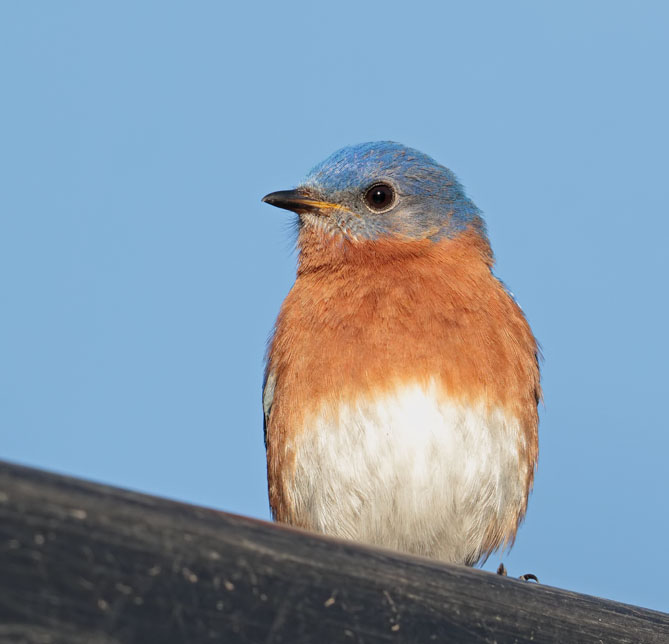 |
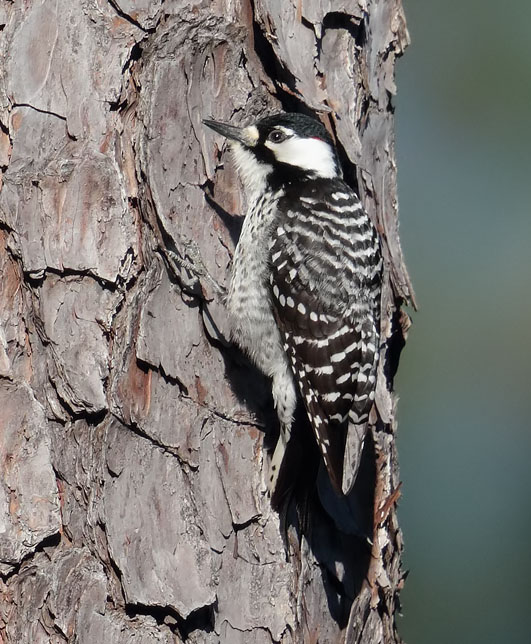 |
| Eastern Bluebird in
the car park |
Red-cockaded
Woodpecker
(note the tiny red cockade on the side of
the head!) |
My final visit to this site was just before I collected the
wife from the airport a week later when I was really just
killing some time after collecting the (defective) hire car.
Again it was late afternoon and I just walked round the same
loop as before. Again I found an RCW almost
without trying, by the tapping sound it was
making as it fed. This time it was along the northern boundary
trail. They appear to be quite common in this nicely accessible
and compact corner of this forest. Other species seen at this site included a Northern Cardinal
and Carolina Chickadee.
The forest map I downloaded shows many other trails
throughout the forest, also
with other RCW clusters, so they might well be
worth trying, but the RCW trail proved pretty reliable for me.
Sam Houston National Forest
(GPS
30.488850, -95.137887)
The Sam Houston
forest covers an immense area north of Conroe and was also said
to contain various sites for Red-cockaded Woodpecker.
Prior to my trip, one of them sounded like it might be a better
bet than the W G Jones State Forest. So despite having seen them
well at W G Jones, I made the mistake of thinking they
might be even easier to find at this site, which was described
as a lay-by with a display plaque, said to be "a very
popular site and gets many visitors".
It was however about 45
miles from W G Jones so the drive there (in a north easterly
direction across country on relatively small but quiet roads)
took me the better part of an hour. Arriving at exactly the right spot,
courtesy of the Sat Nav, the site did not appear as described.
Any display plaque was long gone (but evidence of its mount
remained), and the undergrowth was smouldering from a recent
fire (possibly a controlled burn?). It also proved impenetrable,
so I could only view from the road. In my short visit the only bird activity was distant Brown-headed
Nuthatch calls from invisible birds high in the canopy.
There was no evidence of any recent visitors nor any
RCWs. So pretty much a fruitless journey! Clearly my
info for this site was badly out of date, and I can't recommend
a visit - any birders looking for Red-cockaded
Woodpecker would be much better trying the W G Jones
Forest, as described above, which is also convenient for the
airport.
Sheldon Lake
(GPS
29.883093, -95.185956 )
Needing to end up
in Galveston that evening for my business commitment, my aim, after the
fruitless diversion to the Sam Houston Forest, was to track down
the eastern side of Houston, taking in a couple of sites
en-route. The first of these was Sheldon Lake, which is
mentioned as a birding site in some of the info I had studied in
advance. This lake covers a large area and access wasn't
obvious. Looking at Google Earth, there appeared to be a small
area at the northern end that might afford some access just off
the road, so that is where I started (GPS coords above). This turned out to be a fishermans hangout but there were a few birds present, although
nothing very notable. These included a very confiding
Great Egret. Also Anhinga, American
Coot and Pied-billed Grebe. Overhead
there were some hirundines that were probably
Northern Rough winged Swallows, despite it being mid
winter!
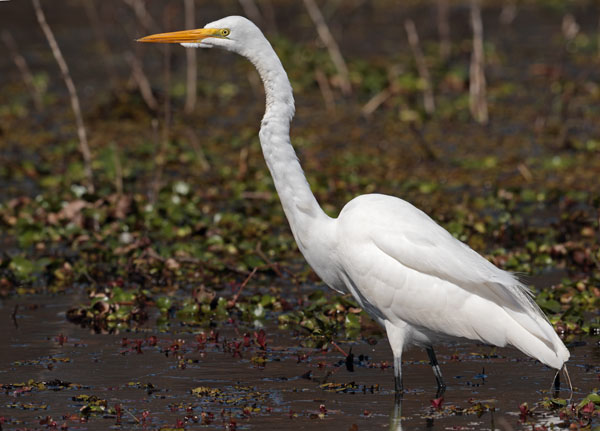 |
| Great Egret (click to
enlarge) |
A possible further access point down the western shore,
which looked from Google Earth to be a boardwalk out into the
lake turned out to be a dead loss - clearly something wooden had been
there once, but was now long gone!
San Jancinto Battleground Park
(GPS
29.741303, -95.076177 )
This site is
mentioned in several places as a winter site for Hooded
Merganser which was another target species for me. So I visited
here three times in a fruitless attempt to
find one! The causeway (GPS coords above) seemed the
obvious place to try for them (and was mentioned in one place). However,
arriving at the causeway, I found on the eastern side the water level was
very low with a lot of exposed mud. This was good for both
Green-winged Teal & Shoveler,
and also a few Blue-winged Teal but was clearly
totally unsuitable for Hooded Merganser. Perhaps in the past the
water levels have been much higher here? On the western side,
there was deeper water but this held very little - only the odd
Great Blue Heron, a small flock of
Gadwall and several Black Vultures
hanging around a pylon.
This was however a varied and quite interesting site overall.
The mud had a few distant waders - mostly Least
Sandpipers, as well as Roseate Spoonbills,
Snowy Egret etc, while the open wooded areas
had flocks of Cedar Waxwing, American
Goldfinch and the first trip sighting of
Yellow-rumped Warblers. Subsequently I saw and heard
(they
have a distinctive call) these practically everywhere -
very soon I was hoping they were something different, but they seldom
were!
On a later early evening visit, the Black Vultures
descended onto the causeway and gave extraordinarily close views
from the car - which was an excellent hide for photography as I
had expected it to be on this trip. Also seen from the causeway
was a nice Belted Kingfisher on a wire over the
water, but again there was no sign of any Hooded Mergansers, as
was the case on my final visit the following morning. Still I
had a couple of other possible sites for these, so I hoped one
or other of these would produce the goods. They didn't but I
didn't know that at the time!
There were plenty of sparrows around as well, but I think all
were just Savannah Sparrows - another
incredibly numerous species seen and heard thereafter almost
everywhere. Unfortunately, I failed to locate any of the rarer
sparrows that I hoped to find on this trip, despite keeping my
eye out for them.
 |
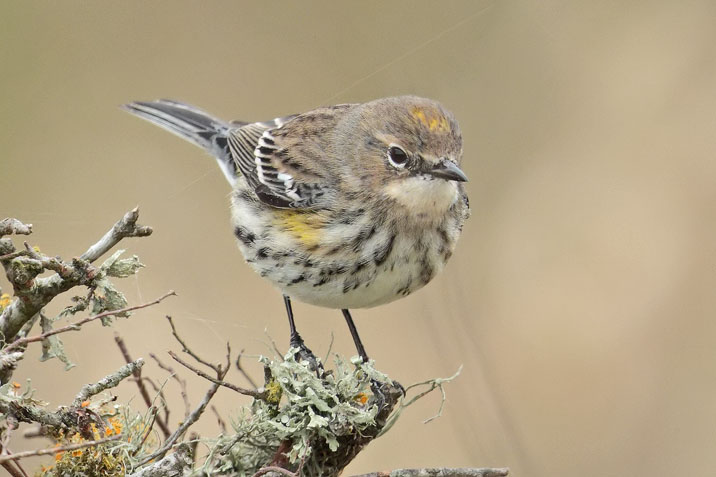 |
| Great Blue Heron (click to
enlarge) |
Yellow rumped Warbler |
 |
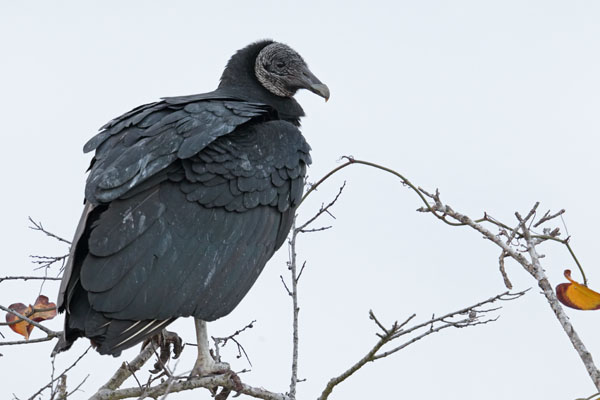 |
| Cedar Waxwing |
Black Vulture (click
to enlarge) |
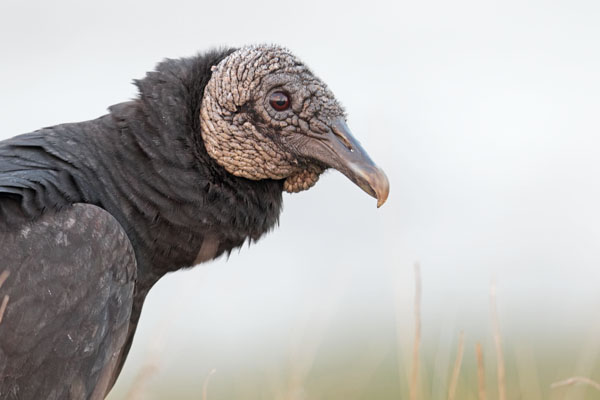 |
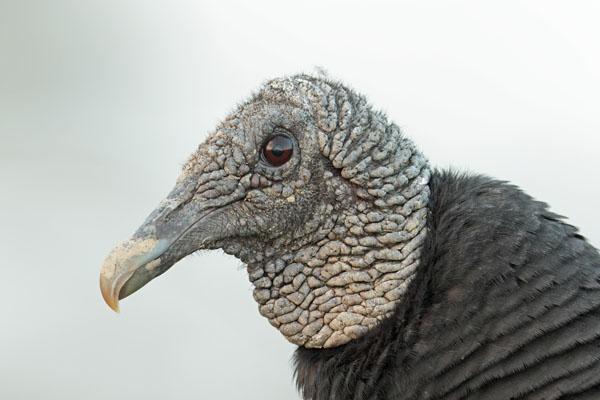 |
|
More Black Vultures (click left to enlarge) |
Katy Prairie
Katy Prairie covers a large area
to the west of Houston and contains some relict areas of old
prairie habitat. There were several sites on the "Katy Prairie
Loop" of the Texas Birding Trails that sounded worth a visit.
After I had first
visited San Jancinto (see above) first thing in a final unsuccessful attempt
to find Hooded Merganser, I then headed over to the Katy
Prairie, going straight across Houston in what I hoped was
reasonably quiet mid morning traffic. I had no problems and was at
my first Katy site about an hour later.
Paul D. Rushing Park
(GPS
29.903910, -95.815131 side entrance:
GPS
29.900654, -95.819865)
I visited this park
a couple of times but it was definitely better on my first
mid-morning Friday visit when it was much quieter than for than
my second short visit on mid afternoon Saturday. A good map of
the park can be downloaded from
here.
Arriving first at the side entrance, I had a surprisingly
productive walk around this park that contains a series of
artificial lakes. The short grass between the car parking and
the first lake had a reasonably tame Long-billed Curlew,
and the first of many wary Killdeers. On the water
was, to my surprise, a great lifer in the form of several
Canvasback. This duck had led me a merry
occasional dance over a period exceeding 30 years. It is
always satisfying to finally catch up with something that has
been missed previously! There were also several Wilsons Snipe
around the muddy margins. Other birds on the more distant pools
included American White Pelicans and
American Wigeon. The short grass also had large flocks
of various blackbird and grackle species, including
Brewers Blackbird and Brown-headed Cowbird.
Having walked all round the pools without the lens, I
returned to the car to retrieve it for the Long-billed
Curlew. I then drove round to the main car park which
is closer to most of the lakes, to carry the lens in for record
shots of the Canvasback that were not obliging at all - the
closest they came was the middle of the lake, when others walked
round the far side.
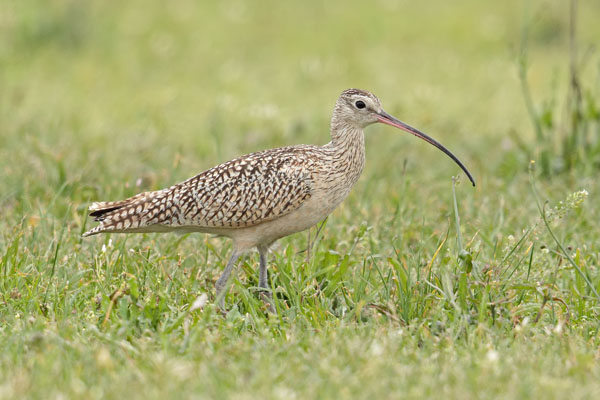 |
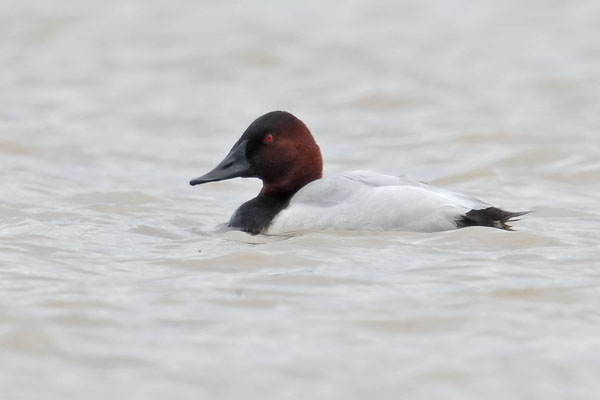 |
| Reasonably close
Long-billed Curlew (click to enlarge) |
Distant Canvasback |
Sharp and other adjacent roads
(GPS
29.920976, -95.840436 )
After visiting the Paul Harding Park, I tried driving
slowly along some of the local roads that are part of the Katy
Loop Birding Trail. These sounded quite good with a fair
potential for some of the rarer sparrows etc. However I wasn't
particularly successful. Best birds were
Crested Caracara, Red-tailed Hawk,
Red-bellied Woodpecker and a few waders on the
wetter areas, including plenty of Killdeer. But
everything seemed very wary (is there a lot of shooting around
here?) and there was little or no access away from the road, nor
any sign of Sparrows other than the omnipresent Savannah. This
coupled with the miserable grey, cold conditions that day (and
the next) meant I won't be in a hurry to go back here any time
soon!
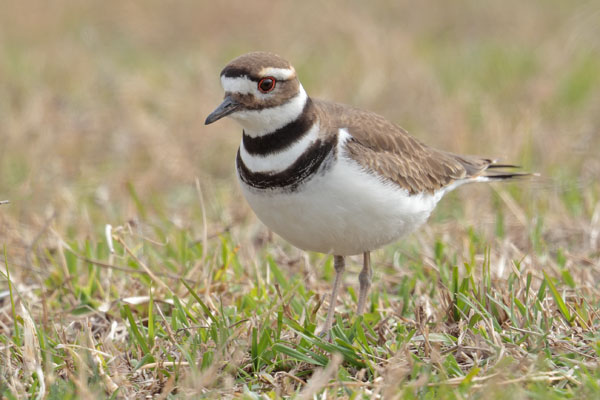 |
 |
| Killdeer |
Red tailed Hawk |
Warren Lake
(GPS
29.978565, -95.847252 )
The descriptions I read online and in the site
guides of Warren Lake, with its flocks of Snow Goose
(with a few Ross' Geese for good measure) coming into roost and wildfowl
on the water, were the main reason for my visit to the Katy
Prairie area, with some pre-booked accommodation not too far away. So
towards dusk, I made my way to this quite isolated site with its
small, deserted car park and impressive
viewing ramp. A word of caution about this car park - it has an
electrically operated remote controlled gate, with a notice
which says
no exit after 18:00. It means it! Having moved my car out of it
just in case, on the dot of 18:00 the gate abruptly closed - not
a good place to be stuck for the night on a very cool, windy
evening!
When I had arrived about an hour earlier, I was somewhat
dismayed to find an almost complete absence of any duck on the
water, or anything else for that matter. But thinking the geese
would arrive around dusk, I hung around by or in the car (for
warmth!) until then. During this time there was little to see
apart from a pair of displaying Red-tailed Hawks in the trees
behind. At about 17:45, after moving the car out of the car
park, I walked the short distance down to the viewing ramp which
is quite close to the water's edge and waited. There was some
reward in the form of a brief fly-past from a Bald
Eagle. The photo below with the 500f4 is pretty
impressive considering the birds distance, the strong wind and
the absence of light (it was nearly dark)! But of the
geese, there was no sign whatsoever. When it was almost
completely dark, I gave up, distinctly unimpressed, and headed
away from Houston for about 30mins to my secluded overnight stay - that was sufficiently far away from the city not to
command "Superbowl" rates!
 |
| Distant fly by Bald
Eagle at dusk |
Route 559 (Crump Ferry Road)
(GPS
29.9172805,-96.032644)
The following morning, I first tried another of
the roads mentioned for the Katy Bird Trail loop with similar
results to yesterday, so I thought I would head back to Rushing
Park which had been reasonable the previous day. En route, I suddenly
noticed a distant sea of white, which I thought could be only
one thing - although it was cold, snow was not on the cards!
Despite being apparently in the middle of Saturday morning
cycling event, I managed to pull off the road to confirm that
this was indeed a distant flock of Snow Geese!
Excellent!
I then noticed another part of the flock much closer to the
road, so I turned round and again managed to park off the road
on a slightly raised bank, giving an excellent view over a most
impressive flock of these delightful geese. I spent some time
here taking large numbers of rather too distant photos of them
on the ground, and in the flight.
Looking carefully through the flock (only with bins) I found a
few smaller geese that were definitely another of my key trip
targets - Ross' Goose.
This time with these geese was definitely one of the main highlights of this
trip, and made up for the disappointment at Warren Lake the day
before.
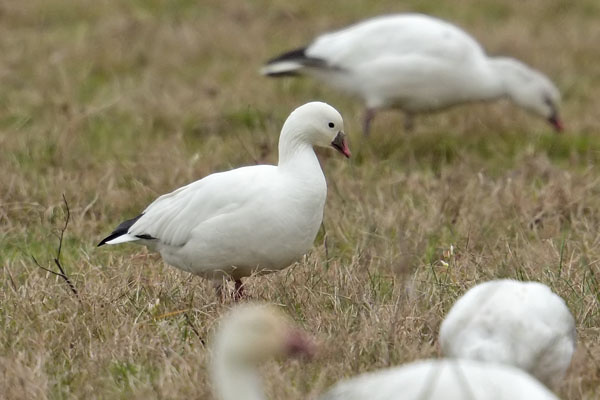 |
 |
| Ross' Goose
|
Snow Geese |
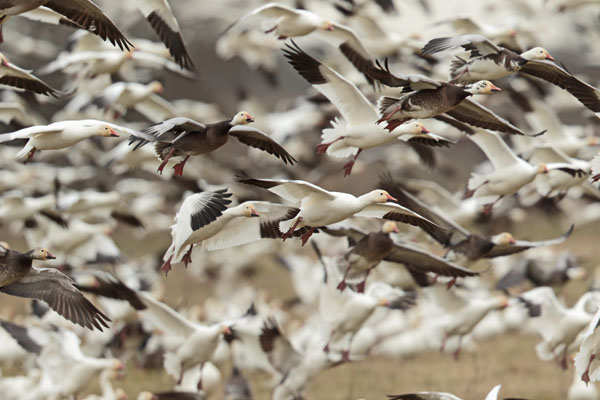 |
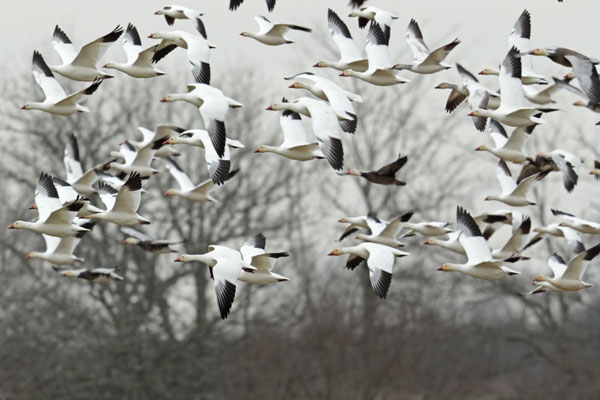 |
|
Mixed flock of mostly Snow & a few Ross' Geese
(click to enlarge) |
Almost exactly a week later, I returned to this area with my
wife on our way back to Houston airport, and again found the goose
flock in much better conditions (warm and reasonably sunny!) in the same
general area. We first spotted them from the original site but
they were on the southern side of the 559 in a flooded field and
could be approached quite closely by driving down a farm track.
The flock then flew off to the east, but by heading along the
559 in that direction we relocated them down another side road at
about
GPS 29.9112331,-95.9853028. They were more distant here and
rather into the sun, but there were some photo opportunities as
small groups of birds kept dropping into the forward edge of the
ever advancing edge of the flock.
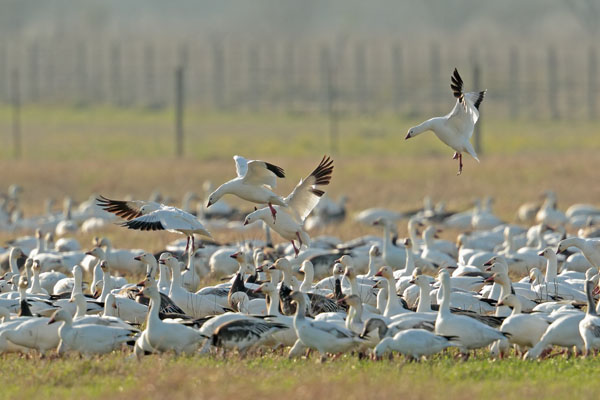 |
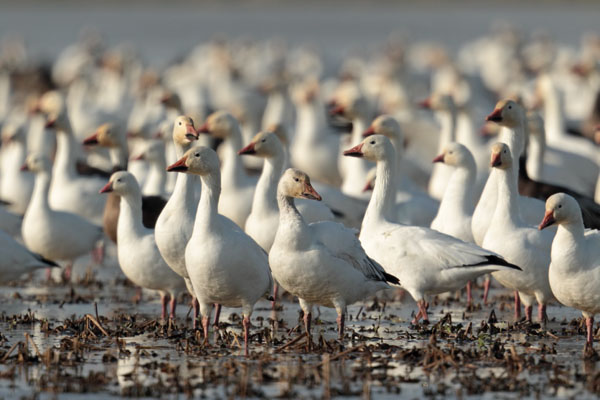 |
| Ross' Goose dropping
into the flock (click to enlarge) |
Snow Geese (and a few
Ross' Geese) in a
flooded field (click to enlarge) |
|
|
|
|
Galveston area
We spent three nights in Galveston, and combined a bit of
tourism with some birding.
Galveston Harbour
The harbour was
within easy walking distance of our hotel and was the place
where huge cruise liners depart. However, immediately to
the east is a tourist area with bay-side restaurants and behind
is a small harbour for fishing boats. I visited here twice but
only on the second time did I take a camera, having seen the
potential on the first visit! The pelicans of both species were
most confiding here, and were clearly used to free takeaways
from the boats, as we saw the first morning. Returning in the
late afternoon with a camera, there were no fishing boats just
in, but the low sun produced some nice light when it was
shining.
 |
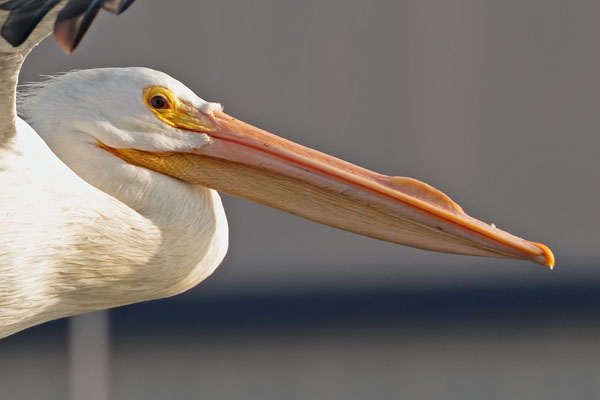 |
|
American White Pelican (click left to enlarge) |
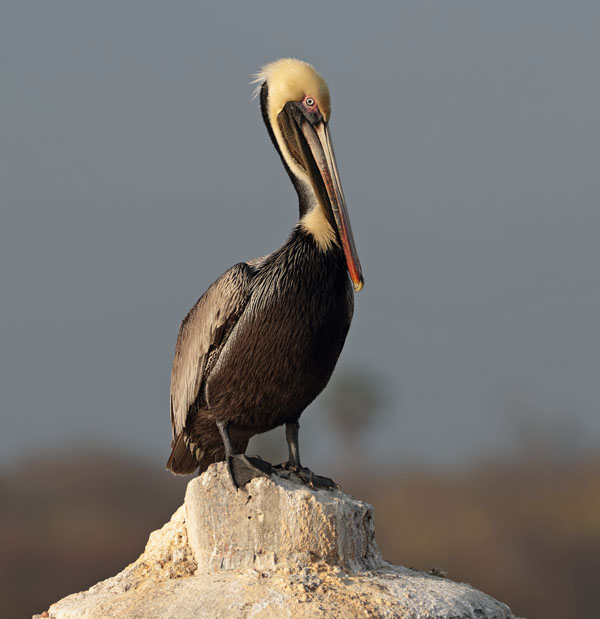 |
|
Brown Pelican (click to enlarge) |
8 mile and Sportsman road
(GPS
29.265507, -94.899401 )
This site is only a
few miles from central Galveston. We had a pleasant late
afternoon visit here at the end of our first day in Galveston
- these two roads
were pretty good for birding and photography from the car. Generally birds seemed more
approachable in the Galveston and Rockport areas than they had
been at Katy Prairie for example. I have no idea why!
8 mile road heads across the island from the coast side to
the bay area and passes various shallow ponds that had a few
duck, including wary Blue-winged Teal, some distant
Sandhill
Cranes, and this closer singing Eastern Meadowlark.
There was also a White-tailed (or
Black-Shouldered in my aged book) Kite
on wires along this stretch - which turned out to be an
unexpected lifer for me, as it's not the same species as the
European Black-shouldered Kite!
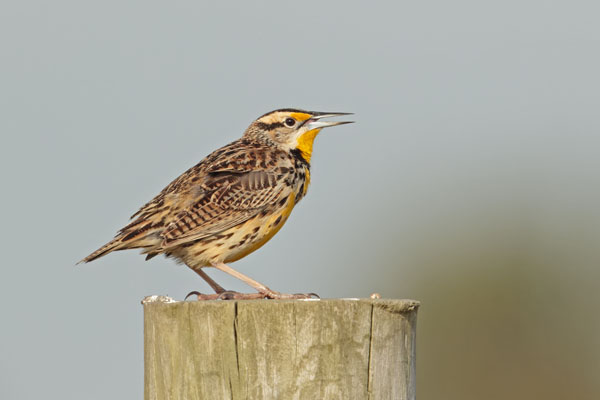 |
 |
| Eastern Meadowlark
(click to enlarge) |
White Ibis (click to
enlarge) |
Sportsman Road, reached at the end of 8 mile Road,
was better for photography with its marshy area
pretty well all along its
southern edge. First off was
this stunning Osprey eating a fish on top of a post by the road.
I can't imagine getting this close to one in the UK, even using
the car as a hide!
Further on, there was some open water with Little Blue
Heron,
Yellow-crowned Night Heron and Tri-coloured Heron, as well as White Ibis. The
Little Blue
was particularly tame even when we were out of the car - I had
to walk away to get the whole bird in the field of view! Over
the marshes were some distant terns - one of which was a
definite Caspian. Near the end of the road,
behind some houses, we also came across a somewhat distant pier
with a load of roosting waders (it was high tide) that included
Ruddy Turnstone, Willets,
American Oystercatcher and several
Short-billed
Dowitchers (thanks to Ian Lewington for the ID!). In the
water was a Red-breasted Merganser and a
Common Loon. So a pleasant spot in the late
afternoon sun.
 |
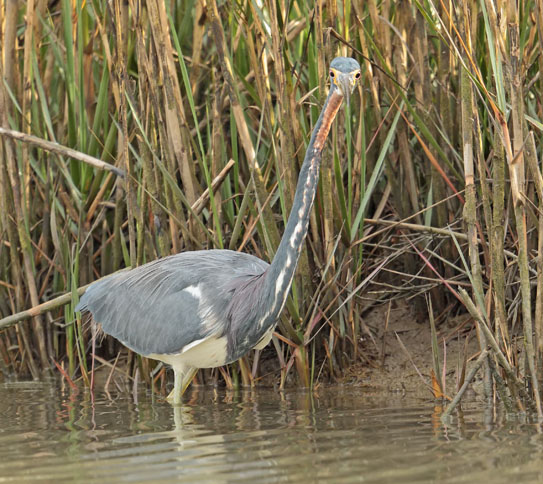 |
| Osprey (click to
enlarge)
|
Tri Coloured Heron |
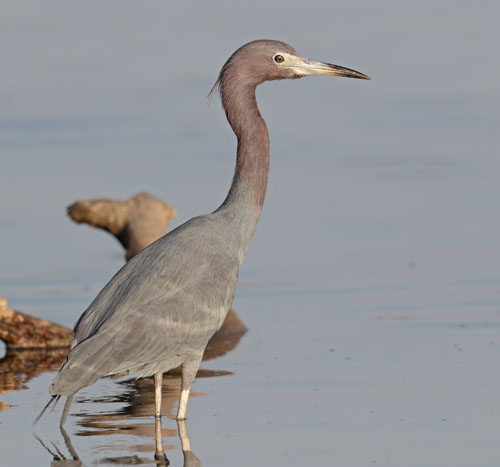 |
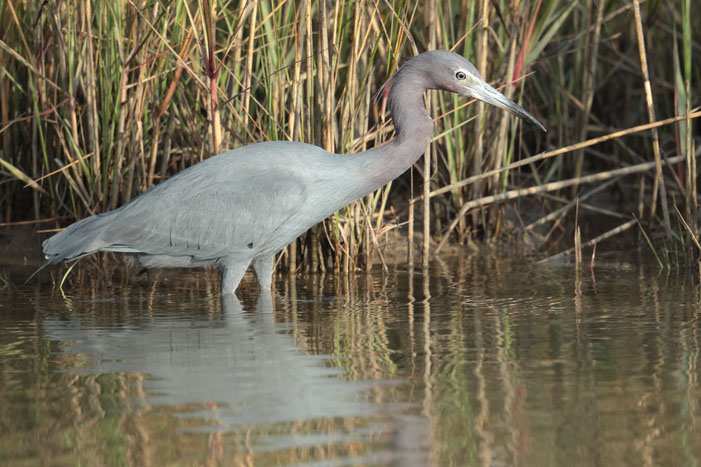 |
| Little
Blue Heron (click to enlarge) |
Settegast Road
(GPS
29.224804, -94.934257)
This site is a few
miles further west than 8 mile Road, and we visited it on the
second morning of our stay in Galveston which was again warm and
sometimes sunny. En-route to the end of this road, we came
across a strange place that seemed to be a mini nature reserve,
with various display boards at 29.223689,-94.928529. Here,
right by the road, was an extraordinarily obliging group of
Sandhill Cranes, that even tolerated me getting
out of the car on the opposite side to them - so I could take these pics. We then went for a short walk along a path that went
through an area with small ponds (only birds were more
Meadowlarks) and out onto the tidal bay foreshore. This
appeared promising for the rarer sparrows but all we could find
was yet more Savannahs. More interesting was a
distant Northern Harrier.
Returning towards the car we came across the only
photographable dragonfly of the trip - see the end of this page
-
before finding a pair of White-tailed Kites,
one of which came quite close. Unfortunately the closest shot
was directly into the sun, but thereafter it wheeled around to
give better lighting.
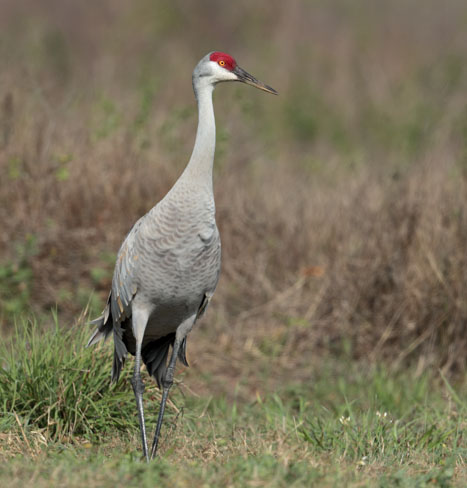 |
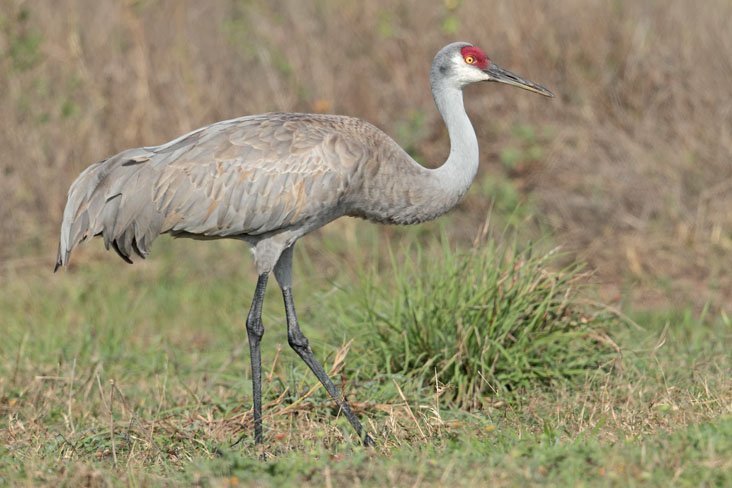 |
|
Sandhill Cranes (click to enlarge) |
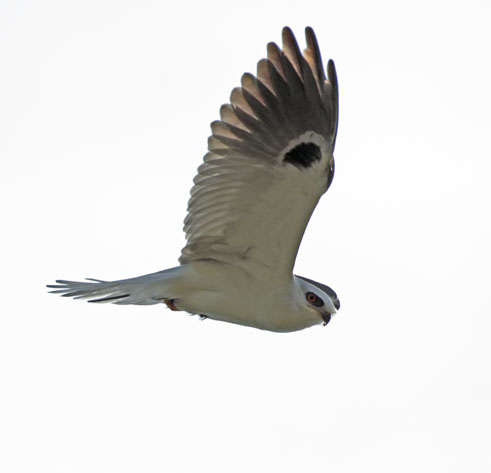 |
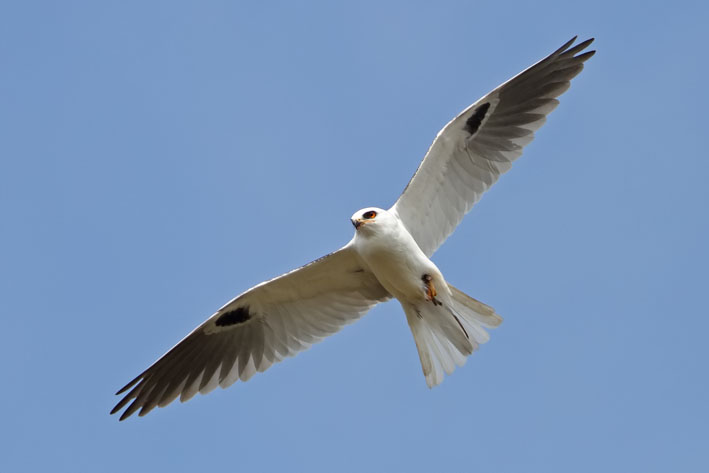 |
|
White-tailed Kite (click right to enlarge) |
At the end of this road, there was a row of large houses with
a private road. It was for here that I'd seen a record of
Harris' Sparrow in a web report, but of course there was no sign
of anything like that when we were there. We could only find a
Belted Kingfisher and some Pied-billed
Grebes in the bay (there is a boardwalk here that gives
good views).
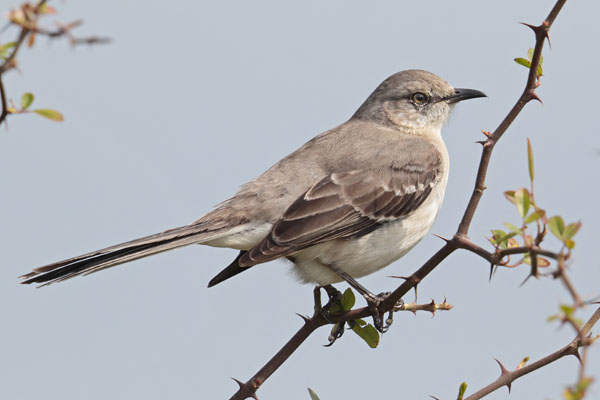 |
| Northern Mockingbird
|
Galveston Island State Park
(GPS
29.195833, -94.955862 )
This site is a few
miles further west than Settegast Road and has a number of
trails on the bay side. We went for a fair walk that went out
towards the bay but didn't see a great deal new for our efforts.
Offshore there was a flock of duck that turned out to be mostly
Redhead, and there were a couple of
Forster's Terns fishing. There was also
a Northern Harrier that kept its distance. That was about it apart from a pool
by the road that briefly had a large
concentration of Roseate Spoonbills, Ibises, Herons
and Egrets before they all flew off.
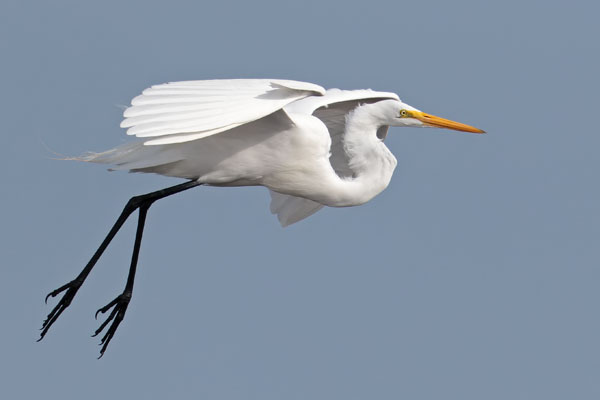 |
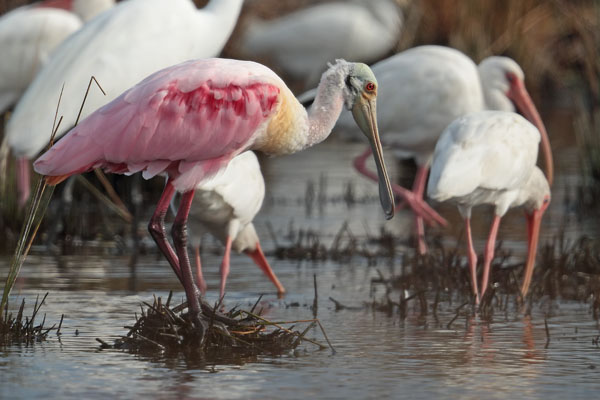 |
|
Great Egret
|
Roseate Spoonbill |
Surfside
(GPS
28.949497, -95.299470)
The next day we
departed Galveston and headed south and west towards Rockport
that was to be our base for the next 4 nights. As this was some
200 miles away, we aimed to take in a couple of sites
en-route. The first was the levees immediately
north of Surfside, which had produced a web report of a group of
Hooded Mergansers ("where they normally are") from a few years
back. But of these, there was no sign at all at the location we
tried. Perhaps we were in the wrong place or they have since
moved on - we will probably never know! However, immediately
prior to reaching the bay, there was an amazing spot with
herons, egrets etc close by on both sides of the road, with this
Yellow-crowned Night Heron probably the pick of
the bunch. There was also a very close Red-winged Blackbird,
showing the value of the car as a hide again.
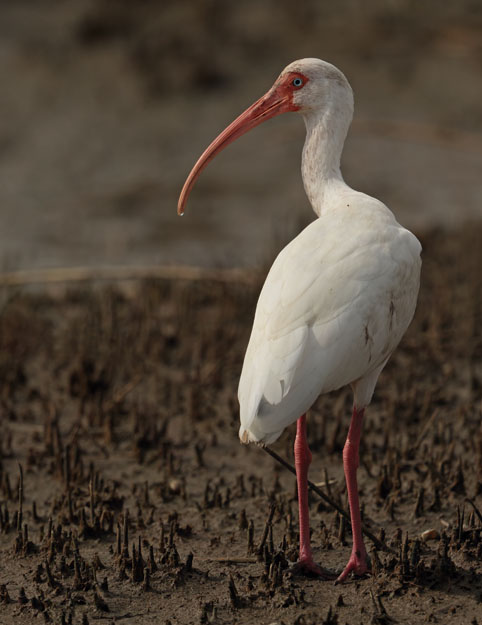 |
 |
| White Ibis (click to
enlarge) |
Yellow Crowned Night
Heron (click to enlarge) |
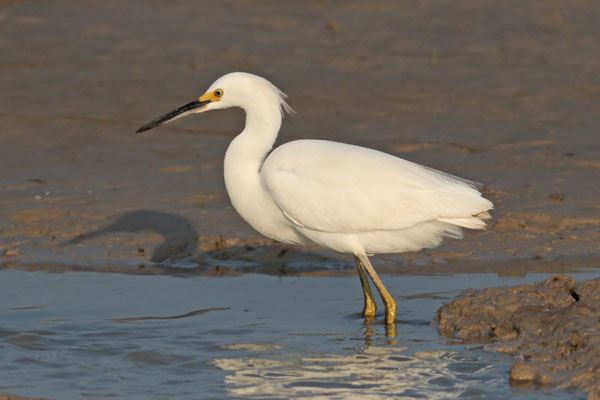 |
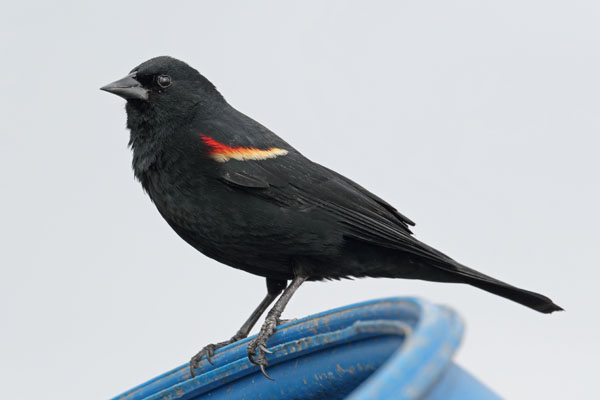 |
|
Snowy Egret |
Red
winged Blackbird |
San Bernard NWR
(GPS
28.91503,-95.57906 )
This National
Wildlife Refuge was our next stop en-route to Rockport as the
proprietor of the Hempstead Inn, where I had stayed for my Katy
Prairie visit, had recommended it for Snow Geese and other
species. On arrival, we drove down the straight road to the
Cedar Lake Creek seeing little apart from a Solitary
Vireo in the hedge, in addition to the ever present
Yellow-rumped Warblers. The road east to the
Moccasin Pond was more productive with quite close Snow
Geese in the overgrown pond (with masses more in the
distance to the right). There were also plenty of the usual water birds in
the pond, but clear shots were difficult due to all the
vegetation.
Glossy
Ibis were also present in good numbers.
Overhead at some point were our only White-tailed Hawks
of the trip.
We then went on a walk along the Cow Trap Trail that led into
the marshes. This was notable for several quite large
alligators in the pools right by the path,
Forster's Terns, and very distant Snow Geese
flocks.
We left this site via the Rail Pond which didn't produce any
rails but did have plenty of the now familiar water birds, as
well as Black-necked Stilts,
Black-crowned Night Heron, White-fronted Geese
and Sandhill Cranes.
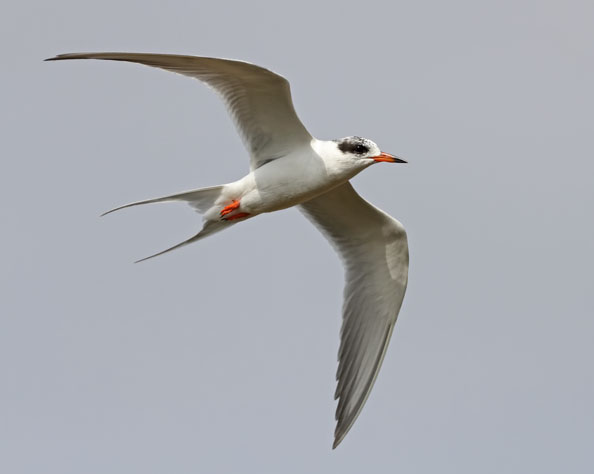 |
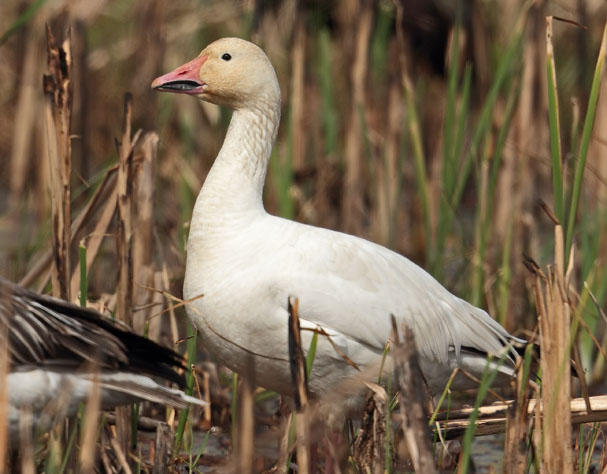 |
|
Forster's Tern (click to enlarge) |
Snow Goose |
Rockport area
We spent four nights in
the Rockport area, with the main aim of finding Whooping Crane
which presented no problems at all.
Big Tree and Goose Island
State Park
(GPS
28.151765, -96.976757 )
This site was only
about 15mins from our hotel and we visited it several times. Big
Tree is a well known site for Whooping Cranes, and attracts
plenty of people driving around the area. On our first visit,
we headed for the Big Tree itself (GPS coords above), which is
an apt description of a tourist attraction just off the road. On
the other side, is a large fenced field with a pool in the
middle that generally had a family party of Whooping Cranes in
it. We spotted them within about 30 seconds of our arrival! The
field is however large, and getting good photos is unlikely -
although waiting patiently in the north east corner might well
pay dividends for flight shots as they come and go. It is
possible to drive round three sides of this field but the birds
generally appeared to prefer the centre - well away from any of
the fences. Also in this field were Black-bellied Whistling
Duck (on the pond) and Sandhill Cranes. A little
further south at about 28.144117,-96.979019 we once came across
a family party of Whooping Cranes somewhat closer to the road at a feeding station
which also attracted Sandhill Cranes (dancing occasionally).
Whooping Cranes are unusual in that they are territorial in
winter and hence do not gather in flocks. Family parties
of small numbers of birds (typically 2-3) are the norm, with the
odd single birds here and there.
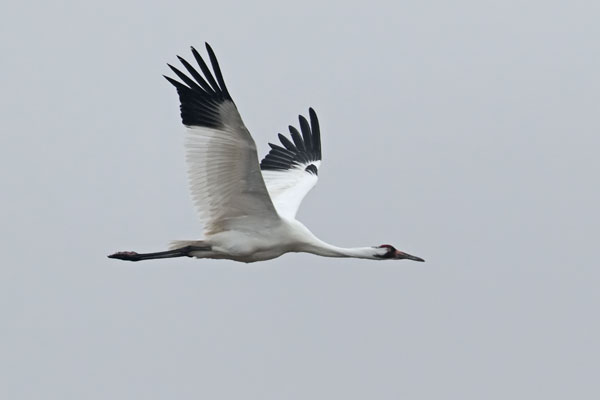 |
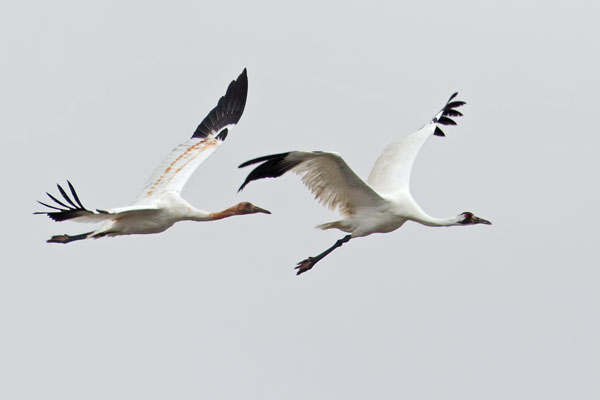 |
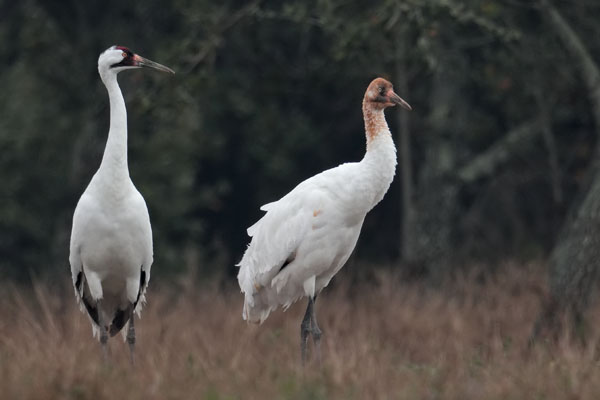 |
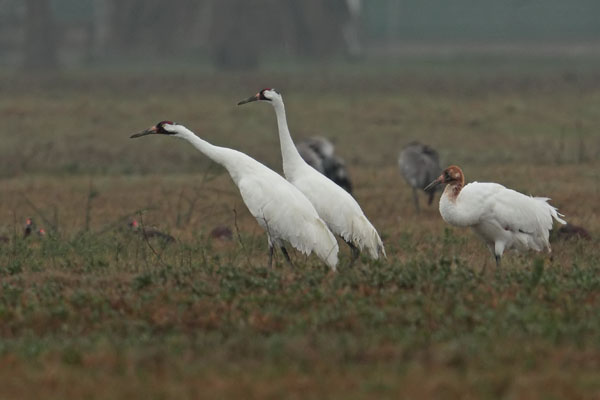 |
|
Whooping Cranes for free at Big Tree (click top right
& bottom left to enlarge)! |
Offshore, there were
close in Redhead and close to the crane feeding
station was a roadside pool full of Black-crowned
Night Herons.
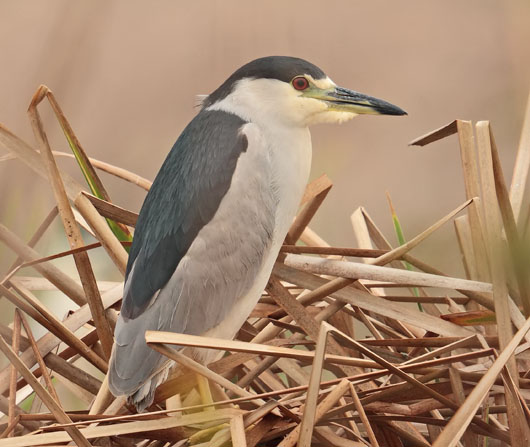 |
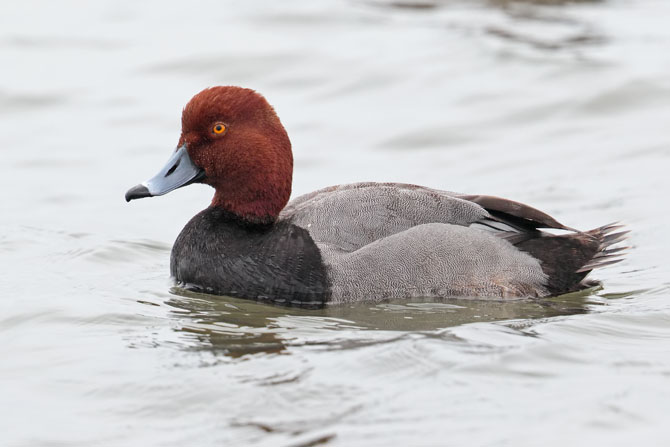 |
|
Black-crowned Night Heron |
Redhead (click to
enlarge) |
Goose Island State Park
(GPS
28.133438,-96.984428 )
Big Tree is an outlying part of this state park site
for which an entry fee of $5 per person is payable. We visited
here briefly a couple of times but longer visits could have
turned up more. It was very crowded and full of RVs but
nevertheless held some reasonable birds, including a good flock
of Black Skimmers resting on the mud at the western end
(28.128115, -96.989593). Having found them on our first visit,
we also tried again en-route to Houston on our last day but this
was spoilt by a family with small children that flushed them
all! Other birds here were Lesser Yellowlegs
and Willet. The other end of the park had a fisherman's causeway that headed
out some distance into the shallow bay with Ruddy
Turnstone and pelicans with good views of the sun
setting. On our second visit, I also came across a 'real'
American birder looking for the rarer sparrows. I didn't find
any (and neither had he when I spoke to him) although this is known site for them.
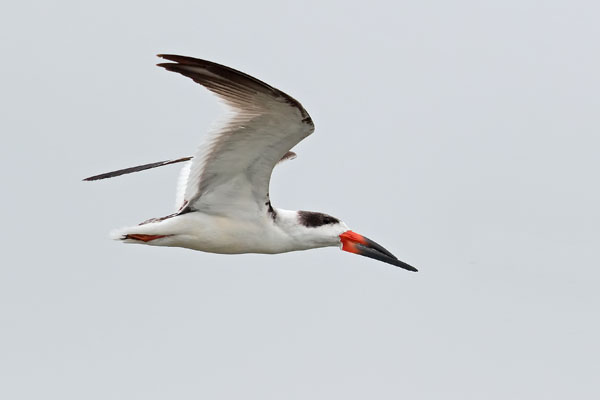 |
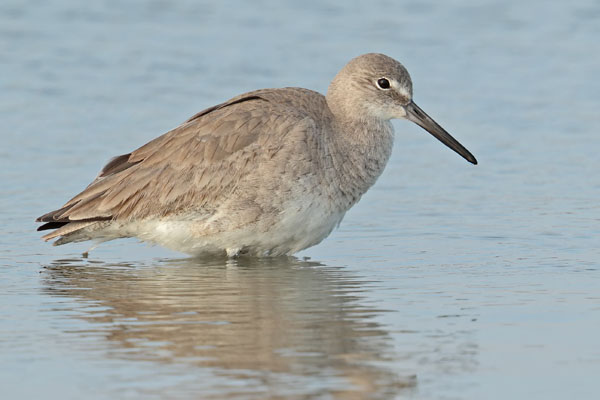 |
|
Black Skimmer |
Willet (click to
enlarge) |
Rockport Aransas NWR boat trip
(GPS
28.063608, -97.034214 )
A boat trip to the famous Aransas NWR was the main objective of this
trip, and it turned out well. Several companies offer tours
departing from Rockport to visit the Aransas NWR for the
wintering Whooping Cranes, but it seems the morning "Skimmer"
boat with
Captain Tommy is one of the best. They offer
a 3 hour tour that departs at 07:30 from Fulton that was very
handy for our hotel. Very fortunately the morning of our tour
dawned sunny and clear, whereas previously (even the day before)
they
had been plagued by early morning fog.
There were quite a few others
on our trip, but most weren't serious photographers so the upper
deck, which provides a good platform for tripods, wasn't too
congested. The boat takes about 30min to reach the NWR, and
Captain Tommy uses a sound system to point out any birds of
interest en-route and after arrival in the shallow waters
immediately off the NWR. There doesn't appear to be any exclusion
zone around the shore or any cranes that happen to be present.
Shortly after arriving off the NWR, we saw various species new
for the trip list, including Royal Tern and
Bufflehead. However
to my disappointment there was no sign of any Hooded Merganser
(that are frequently seen on this trip).
Initially we only had distant
views of a few Whooping Cranes, but shortly we came to one
feeding in a pool very close to the waters edge. It seemed
unperturbed by our presence and the boat got remarkably close -
so much so that at times the bird more than filled the field of view with
the x1.4 on the 500f4! The light was superb with the sun behind
us, and so I took loads of shots. Those showing the bird with a
Blue Crab (its favourite food) were probably the pick of the
bunch.
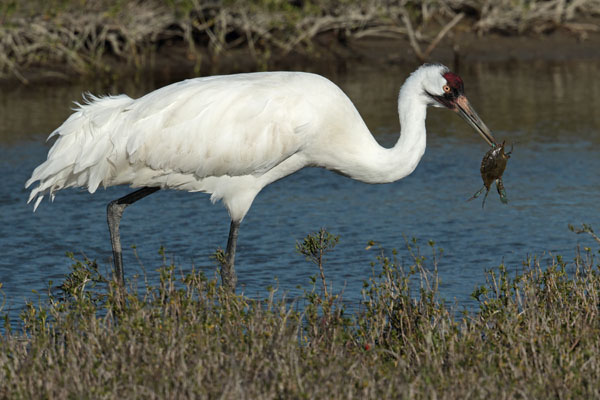 |
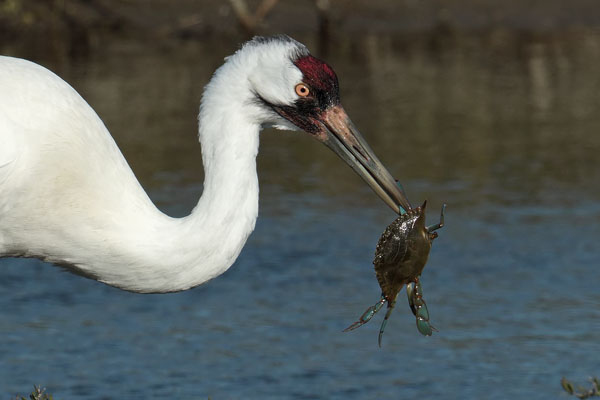 |
|
Whooping Crane from the boat (click to enlarge)! |
After spending plenty of time here, the boat headed off to
see what else could be found. Notables were American Avocet and
a distant American Bittern (little did I know at the time) that
we would come across a much, much closer one later that day!
So all in all this boat trip worked very well for Whooping
Crane pics, although nothing else came within useful photo
range. Definitely recommended and one of main trip highlights.
Aransas NWR
(GPS
28.310933, -96.801266 )
This NWR is famous
for its wintering Whooping Cranes that we had already seen
extremely well on the boat trip and at Big Tree. However the
NWR itself sounded worth a (land) visit for other birds as well. However
the entrance is some distance from Rockport and our
visit on a very hot afternoon (over 90F!) wasn't very
productive. After calling in at the visitor centre, we decided
to walk along the Heron flats trail but saw very little apart
from a few distant waders, a Belted Kingfisher
and a Solitary Vireo in dense cover. When we
had got around 2/3 way round we found that the warning signs at
the start of the trail were accurate - it really was closed, so
we had to retrace our steps!
Getting back in the car we drove further on and soon reached
the shore where there were flocks of duck offshore. Scanning these
produced a couple of additions to the trip list - Lesser Scaup
and Eared Grebe but everything was far too distant for any
photography. At the end of the road is the amazing structure
that is the observation tower - no ladder, nor even steps
are needed - just a ramp, presumably for disabled access. At the
top there are good but very distant views south over the reserve.
Well below and quite close were large number of the now familiar
herons, egrets etc, but the light was awful - looking straight
into the sun. From the higher platform we missed a family party
of 3 Whooping Cranes, but then noticed them at the second, lower
one. They were extremely distant (maybe a mile?) and
considerably to the left of the birds in the foreground.
After this, we drove round the auto loop tour and saw
practically nothing apart from the odd American Kestrel. Perhaps a longer visit, earlier or later in
the day would have been more productive but this reserve didn't
appear promising at all for photography, unlike so many other
places.
Rockport Beach Park
(GPS
28.026947, -97.046365 )
I don't think this
site features in any of the guides, but we came across it by
chance and had a brief but pleasant visit in not brilliant
weather. There were a couple
of butterflies, including an impressive Swallowtail (see below)
and a Marbled Godwit on the beach at one point.
In the bay, seen from the coastal road was a flock of
Redhead and one Canvasback (the only
one I saw apart from at Rushing Park, near Houston).
 |
|
Marbled Godwit (click to enlarge) |
Port Aransas area
We visited Port Aransas on the afternoon of the day we went on
the early morning Whooping Crane boat trip, so it turned out to
be quite a long but successful day. Surprisingly a ferry is
needed to reach here. On the outward leg, we only had a brief 10-15min
delay, but on the return in the rush hour there was quite a
queue and a wait of around 45mins, despite the apparently
efficient operation of multiple boats.
Paradise Pond
(GPS
27.834166, -97.071982 )
This was another
possible Hooded Merganser site that didn't produce, but there
were some other nice birds to be seen with good photo
opportunities as well. The entrance to this compact site is
rather hidden behind the San Juan restaurant but there is a
convenient parking spot right by the entrance track. There is
then a short walk to the pool with a boardwalk allowing close
views of anything on the water. The water level was depressingly
low due to the chronic drought conditions this area has
apparently been
experiencing recently, but nevertheless the pool held some
remarkably tame Blue-winged Teal and
Green-winged Teal, which are normally very wary.
This got me thinking about the Weymouth Hooded Merganser
which is generally regarded as an escape due to its tameness and
liking for bread etc! However the photo I had seen on the web
from this site was of an extremely confiding female Hooded
Merganser. It seems that all the species here are completely
used to people on the boardwalk and don't bother at all about
them - this was also the case for the next site below. I can't
see the Weymouth Hooded Merganser was behaving any differently
from these, clearly wild, birds. So maybe it is a wild bird
after all and
not an escapee?!
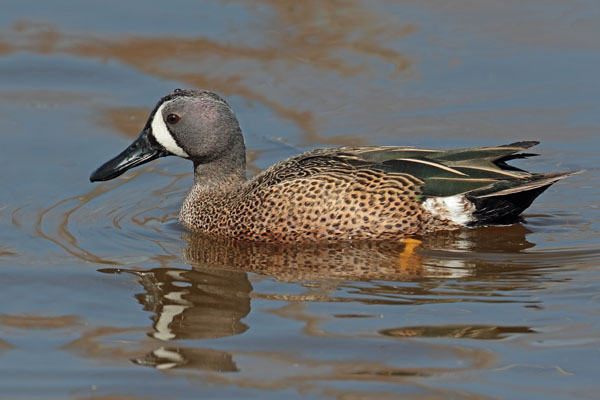 |
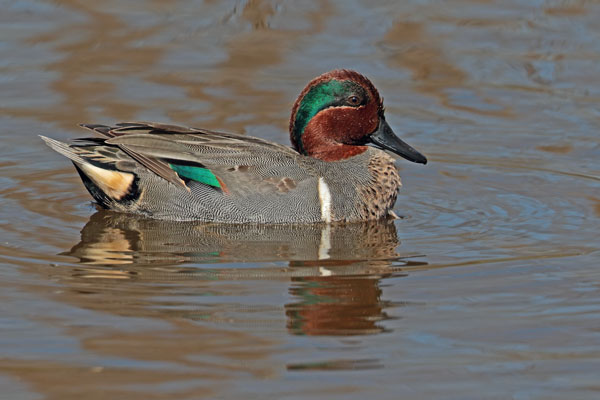 |
|
Blue Winged Teal (click to enlarge) |
Green winged Teal
(click to enlarge) |
We visited this site twice, the
first time was in the middle of the day and it was quite quiet
(apart from the duck). Our second visit was at the end of the afternoon and was
more productive with some RGV species appearing - Inca
Dove (briefly), Great Kiskadee and
Ladder-backed Woodpecker. There was also a
Loggerhead Shrike around.
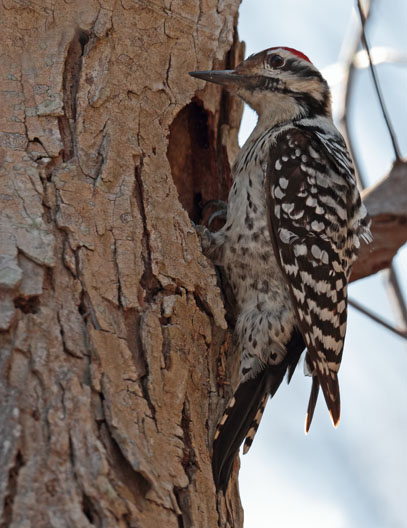 |
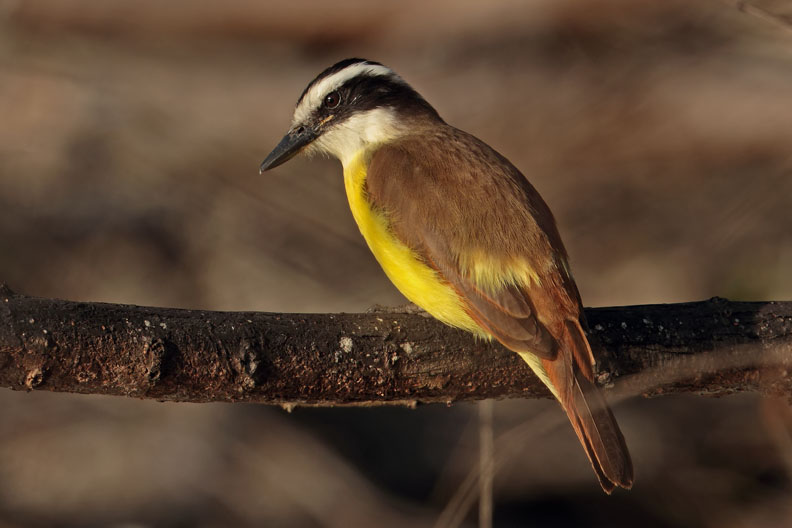 |
|
Ladder backed Woodpecker |
Great Kiskadee
(click to enlarge) |
Leonabelle Turnbull Birding
Center
(GPS
27.827053, -97.078046 )
This site was very
close to Paradise Pond and was extraordinarily popular with a
constant stream of people coming and going. The main attraction
appeared to be two alligators close to the boardwalk which was
longer than that at Paradise Pond. The boardwalk gave very close views of a reedbed and a lake with healthy water levels. Again many birds
were remarkably tame and paid no attention to the constant human
traffic. The most amazing of these was this American
Bittern that showed within a metre or two of the
boardwalk. It was impossible to get anything more than the head
and bill in the field of view of the 500f4, and the 100-400
could only accommodate the whole bird on the lowest zoom (i.e.
100mm)!! A pair of Pied-billed Grebes
were also close, but not that close! Other birds here included
Tri-coloured Heron and various other wildfowl.
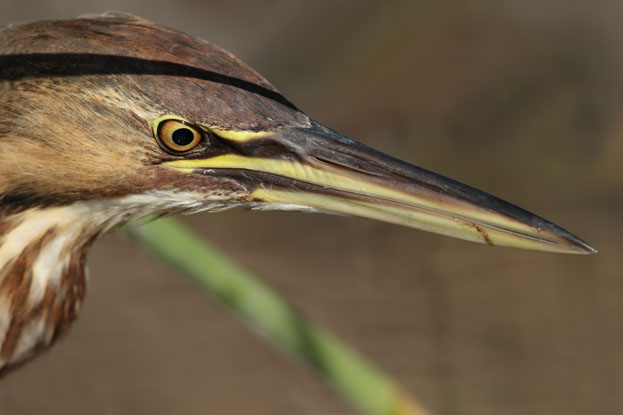 |
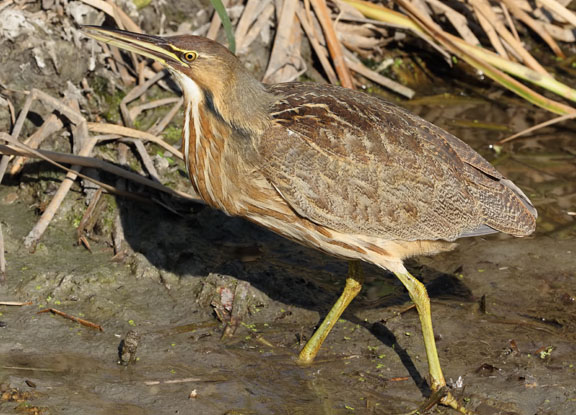 |
|
American Bittern with 500f4 |
American Bittern with
100-400 @100! (click to enlarge) |
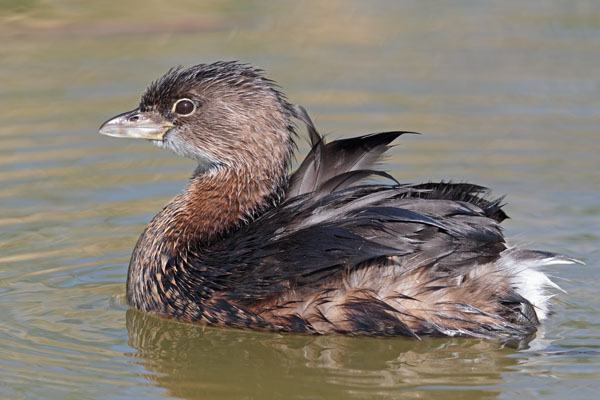 |
| Pied Billed Grebe
(click to enlarge) |
Just after we arrived there was also an amazing
close fly-by of a Northern Harrier, but it was very much into
the sun. Thereafter it showed in the opposite direction but at
more typical (i.e. distant) harrier ranges.
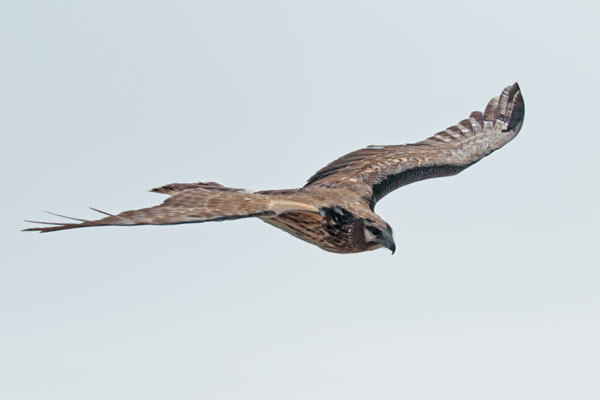 |
 |
|
Northern Harrier - very close but into the sun |
Northern Harrier -
with much better lighting but more distant |
Not birds!
This was primarily
a birding trip but if anything else presented itself, I was
happy to take its photo! Even in mid-winter at these
sub-tropical latitudes there were a few dragonflies around and
the odd butterfly.
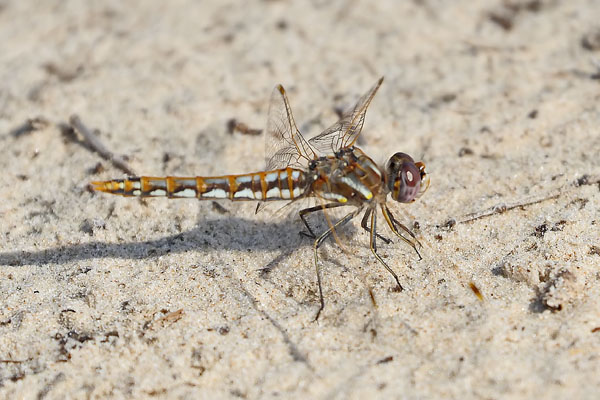 |
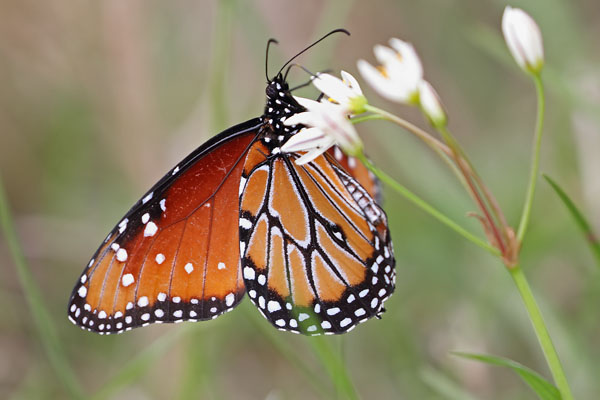 |
| Variagated Meadowhawk
at the reserve on Settegast Road near Galveston |
Queen Butterfly at San
Bernard NWR |
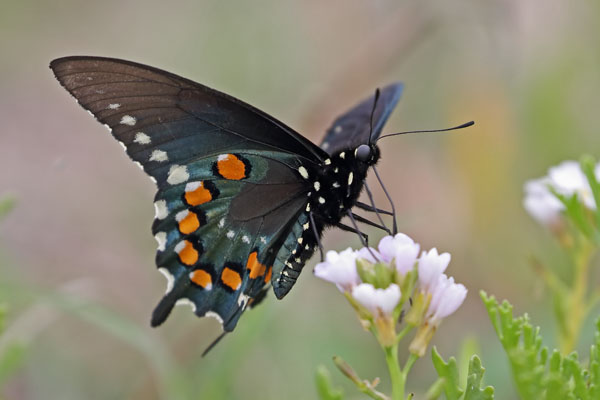 |
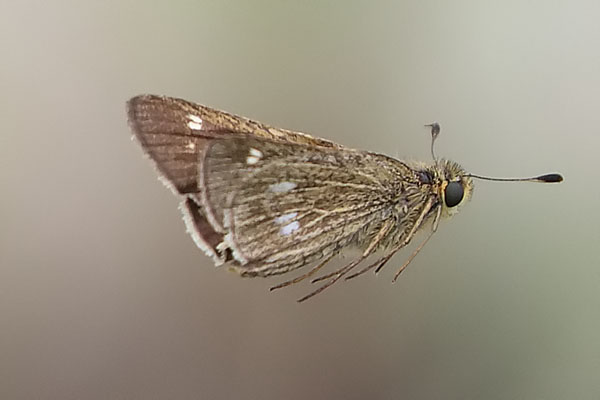 |
| Pipe Vine Swallowtail
at Rockport Beach Park |
Remarkably lucky
flight shot of a probable Whirlabout Skimmer, Rockport
Beach Park |
 |
|
Alligator at San Bernard NWR! |
Accommodation
Details
| Place |
Comment |
|
La Quinta, Conroe |
Quite acceptable hotel at Conroe where I spent one
night after arriving at Houston Airport - convenient for the W
G Jones State Forest with its Red-cockaded Woodpeckers.
Handy Mexican restaurant very close. Room spacious and
comfortable. Breakfast unmemorable but included I think. |
|
Best Western Deer Park Inn and Suites |
Chosen as it was convenient for San Jancinto Memorial
Park and wasn't too expensive on the Thursday before the
Superbowl in Houston. A motel with parking just outside
the room. Room OK but inclusive breakfast no great shakes.
Dinner in a family Italian restaurant recommended by the
helpful receptionist about 3mins drive away (not
memorable!). |
|
Hempstead Country Inn & Suites |
Peaceful place in countryside
well to the north-west of Houston which didn't charge a
Superbowl premium on the Friday night. Reasonably handy
for Katy Prairie. Enthusiastic owner was delighted to find
I was a birder and was most helpful over places to eat
(both breakfast and dinner). The rooms were all on ground
level with outside access. Recommended. |
|
The Tremont House, Galveston |
We spent three nights at this highly rated (on
TripAdvisor) upmarket hotel in Galveston's historic (i.e.
older) district. I didn't understand this hotel's high
ratings. Parking was inconvenient - you either had to pay a
considerable sum for valet parking or find a metered spot
on the adjacent roads. This is what we did after the
first night when we arrived late from the airport and
roadside parking wasn't obvious. If you arrive
late enough and depart in good time in the morning,
roadside parking is free. We had an internal room
overlooking the bar which was hardly ideal but at least
the noise subsided after about 10pm, otherwise we would have
complained and asked for a different room. The breakfast was very expensive - we
only had it once! About its only plus point was its
convenience for the harbour. |
|
Lighthouse Inn,
Rockport |
The best hotel we stayed in, but quite expensive. We
had four nights here in a lovely spacious room with a
balcony directly overlooking the bay with potential for
scenic sun rises and the odd interesting bird offshore
(Common Loon, early one morning). Breakfast was included
and had a good choice - including make your own waffles,
hot buffet etc.
Dinner was less memorable, so we walked to various other
places that were close by for the other nights. One
negative was the paper thin walls - which were very
noticeable one morning! |
© All pictures copyright
Stephen Burch
|